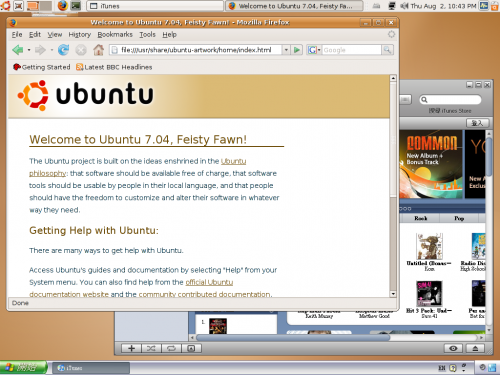自從換了新手機之後,常常被別人以為我拿的是高級 3G 手機:因為我常常在別人面前用手機查 Wikiepdia, Google 或是 GMail。實際上呢,SonyEricssion k550i 的綁約價只要 5500,我一個月的 GPRS 網路費(k550i 不是3G手機)也沒有超過 200 元過。所以,以下解釋一下我達成行動力的方法。
手機
一開始當然是要選一台手機。其實我不換手機用 Nokia 6610 也可以達到一點行動力(原因下面解釋),但是 6610i 的螢幕實在是太小了,JAVA 規格也只有 MIDP1 讓我沒有辦法用某些程式… 因此考量價錢之後我選了 176 x 220 的螢幕,不算大也不算小。
預算不夠不一定要選 3G 手機+資費。GPRS 雖然速度只比撥接快一點點,但是在手機上用 Opera Mini 也算夠用。至於大家會問的 GPRS 太貴的問題,我用起來是覺得除非每天要用手機處理事情一整天(這樣大拇指會斷掉吧),不下載檔案傳輸費是不會爆掉的。最多最多頂多辦個 99 元月費的 GPRS 附加方案。
Opera Mini
 Opera Mini 是 Opera 瀏覽器的手機版本。它和一般瀏覽器不一樣,不是讓手機直接下載網站的資料來顯示,而是經過 Opera 方面的伺服器做預先的處理與壓縮。光是這個動作就拯救了 GPRS —— 雖然 SonyEricssion 手機也有內建不難用的瀏覽器,但是它拿 GPRS 下載網頁所有檔案來顯示需要的時間和傳輸費是很嚇人的。
Opera Mini 是 Opera 瀏覽器的手機版本。它和一般瀏覽器不一樣,不是讓手機直接下載網站的資料來顯示,而是經過 Opera 方面的伺服器做預先的處理與壓縮。光是這個動作就拯救了 GPRS —— 雖然 SonyEricssion 手機也有內建不難用的瀏覽器,但是它拿 GPRS 下載網頁所有檔案來顯示需要的時間和傳輸費是很嚇人的。
我在用 Nokia 6610 的時候就有在用 Opera Mini 了。螢幕只有 128×128,而且 MIDP1 規格雖然勉強可以執行(光這點我就覺得 Opera Mini 超厲害的),但是載入某些網頁會當機。會換手機有很大的因素也是因為 Opera Mini 。
Opera Mini 預先處理是會將網頁編排修改成方便閱讀的形式,之後經過壓縮再傳到手機上。處理的方法是 Opera 的專利,如果該網站有 handhold CSS style 則會遵守CSS。在標準並且有考量到行動裝置的網頁上(例如Wikipedia)閱讀是完全沒有問題的;Yahoo!奇摩拍賣、新聞的畫面勉強可以接受。其他像是無名看起來就非常恐怖了(應該也沒有人想要用手機螢幕逛相簿吧)。查查網路字典或是搜尋也是沒有問題的,拿來上 GMail Mobile 也不錯,不過它有更好用的專用程式。
唯一的例外是 Windows Live Messenger 的手機網頁版本。這個只能用內建瀏覽器啟動,因為 Opera Mini 的網頁沒辦法讓 Javascript 做線上修改,執行所有 Javascript 都要重新傳輸整頁。
GMail
Google 開發了 GMail 的專用 Java Client,MIDP2 規格因此無法在我的舊手機上運作。裝好之後設定帳號密碼進去即可使用。相當好用,數字快速鍵也設計的很用心;從它載入郵件的清單的速度也可以感受到它背後的傳輸是有特別設計過。
Google Maps 也有對應的 Java 程式,不過我的手機跑起來會錯誤就是了。
結語
剛買 k550i 回來的時候發現它內建的網路功能非常完整。除了瀏覽器以外,它也可以收 POP3/IMAP 信件、RSS Reader、用某些手機廠商設計但是不普及的 protocol 同步個人資料和即時訊息、把照片傳上 Blogger (BSP 專屬功能,不是XML-RPC)。
手機這麼好用,為什麼要用 Opera Mini 的 Feed Reader 或是不把 GMail 設定到手機的內建功能上呢?手機還把它們整合進簡訊功能呢!其實如果我用 3G 手機我也會這樣做,只是一切都是為了省錢呀 —— 3G手機的售價,GPRS 的速度和資費。雖然傳輸速度慢,但是軟體可以發揮手機的無限可能…這也不錯不是嗎?
若您有興趣改造手機發揮行動力,去開通 GPRS 然後開始裝程式吧(記得裝程式要從電腦傳不要直接下載喔,檔案有點大):
Update: 樓下的格非大姐姐(XD)寫了一篇如何安裝 Opera Mini 的說明

 Opera Mini 是 Opera 瀏覽器的手機版本。它和一般瀏覽器不一樣,不是讓手機直接下載網站的資料來顯示,而是經過 Opera 方面的伺服器做預先的處理與壓縮。光是這個動作就拯救了 GPRS —— 雖然 SonyEricssion 手機也有內建不難用的瀏覽器,但是它拿 GPRS 下載網頁所有檔案來顯示需要的時間和傳輸費是很嚇人的。
Opera Mini 是 Opera 瀏覽器的手機版本。它和一般瀏覽器不一樣,不是讓手機直接下載網站的資料來顯示,而是經過 Opera 方面的伺服器做預先的處理與壓縮。光是這個動作就拯救了 GPRS —— 雖然 SonyEricssion 手機也有內建不難用的瀏覽器,但是它拿 GPRS 下載網頁所有檔案來顯示需要的時間和傳輸費是很嚇人的。